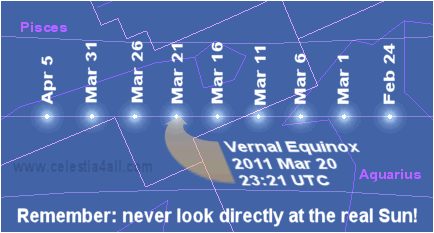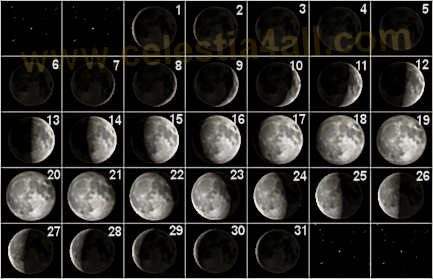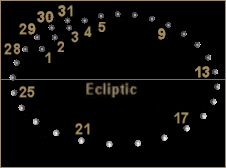








AVAILABLE MONTHS
2010:
Jan
Feb
Mar
Apr
May
Jun
Jul
Aug
Sep
Oct
Nov
Dec
2011:
Jan
Feb
Mar
Apr
May
Jun
![]() 1.6.x & 1.4.1 LINKS
1.6.x & 1.4.1 LINKS
Throughout this website you will find pairs of links labeled "1.6.x" and "1.4.1". Click here for a brief explanation.
UTC: CELESTIA'S DISPLAY OF TIME
CELESTIA's clock displays Coordinated Universal Time, UTC. Click here for a brief explanation.
MARCH 13, TURN CLOCKS FORWARD
"DAYLIGHT SAVINGS TIME" RESUMES
Sunday morning, March 13, marks the time to once again observe the maxim, "Spring Forward, Fall Back," and turn U.S. clocks forward an hour. So 2:00 AM becomes 3:00 AM, etc., and you will get an hour less to sleep that night!
But don't worry that this will somehow throw cosmic time hopelessly out of balance. No, this hour that we "lose" every Spring we "gain" back again every Fall.
APPARENT PATHS OF THE PLANETS
In the month of March, Mars follows Mercury and the Sun eastward out of Aquarius and into Pisces. Before month's end, Pisces is "playing host" to the Sun and four planets! What a gathering!
Note: in the 1.6.x and 1.4.1 links in this column below, planets east ("left") of the Sun are visible in your sky after sunset, while planets west ("right") of the Sun are visible before sunrise.

MERCURY: 2011 Mar
As March begins, Mercury "accelerates" away from the Sun. Then it passes Uranus and Jupiter, before slowing and "going retrograde" at month's end (1.6.x) (1.4.1)
VENUS: 2011 Mar
Heading east, Venus moves entirely through Capricornus this month, passing Neptune near month's end (1.6.x) (1.4.1)
MARS: 2011 Mar
Mars trails Mercury and the Sun out of Aquarius and into Pisces (1.6.x) (1.4.1)
JUPITER & URANUS: 2011 Mar
Continuing to distance itself from slower Uranus, Jupiter leaves the corner of Cetus and enters Pisces. Jupiter is passed by Mercury near mid-month (1.6.x) (1.4.1)
SATURN: 2011 Mar
Saturn remains in retrograde motion for the whole month of March (1.6.x) (1.4.1)
NEPTUNE: 2011 Mar
Slow-moving Neptune lingers in Aquarius, though it stays near the eastern border of Capricornus. Venus passes very close to Neptune near month's end (1.6.x) (1.4.1)
CELES-TIPS
The following will help you enjoy this page's many links that run events directly in CELESTIA. If you're new to the program, these tips will also help you learn to use it.
- If CELESTIA's clock (i.e. the program's date and time) is not visible at the top right of its window, press the V key until you see it. This will also turn on information text in other corners as well. This text will help you keep track of several aspects of the event you're viewing.
- Pressing the "un-shifted" L key and K key respectively will speed up and slow down CELESTIA's flow of time by a factor of 10 in version 1.6.x and 1.4.1.
- Pressing Shift+L and Shift+K respectively will speed up and slow down CELESTIA's flow of time by a factor of 2 in version 1.6.x only.
- Pressing the J key (either shifted or "un-shifted") will reverse CELESTIA's flow of time in version 1.6.x and 1.4.1.
You'll find more information about many of CELESTIA's controls on our Learning Center page.
WELCOME HOME, DISCOVERY!

Image Credit: NASA
WELCOME HOME, DISCOVERY: 2011 Mar 9
THE SUN
APPARENT PATH OF THE SUN: 2011 Mar
Here are the Sun's positions along the Ecliptic at 00:00 UTC on the days shown.

The slightly curved lines above and below the Ecliptic show the extent of the Zodiac, which you may download from our Bonuses page and add to any version of CELESTIA. Note that the curve in the Zodiac lines is the result of CELESTIA's rendering in perspective.
 W A R N I N G ! It is never safe to look directly at the real Sun with the naked eye! Moreover, looking at it through a telescope or binoculars—even for an instant—can cause permanent blindness! NEVER DO IT! Consult the professionals at your local planetarium or observatory to learn how you can safely "observe" the Sun and any SOLAR eclipse!
W A R N I N G ! It is never safe to look directly at the real Sun with the naked eye! Moreover, looking at it through a telescope or binoculars—even for an instant—can cause permanent blindness! NEVER DO IT! Consult the professionals at your local planetarium or observatory to learn how you can safely "observe" the Sun and any SOLAR eclipse!
Of course, you can safely view CELESTIA's depiction of the Sun's apparent path in the sky in March. Here are the links: (1.6.x) (1.4.1). Note that versions 1.6.x and 1.4.1 differ in the way their "follow" and "lock" features work. If you "follow" Earth and then "lock" the Sun to it, versions 1.6.x and 1.4.1 respectively maintain the "attitudes" of the Ecliptic and the the Celestial Equator. This means that the Ecliptic remains "level" when you run the first link, but begins to tilt when you run the second! Differences like this will be discussed on our Help page.
VERNAL EQUINOX: 2011
This year the Vernal Equinox, the 1st day of Spring when the Sun crosses the Celestial Equator and moves into the northern Celestial Hemisphere, occurs on March 20 at 23:21 Universal Time. A more in-depth explanation of the equinoxes can be found on our News page for 2010 March.
HALF OF EARTH IN SUNLIGHT & DARKNESS
During your voyages in CELESTIA, would you like to be able to position yourself directly over the center of the half of Earth in sunlight or the half in darkness at any time this month? On our Tips page, you'll find that it's quite easy to do so! If you're any kind of sky watcher at all, you probably know just how helpful this can be!
THE MOON
PHASES OF THE MOON: 2011 Mar
In UTC per CELESTIA 1.6.x:
New: Mar 4, 20:46. 1st Qtr: Mar 12, 23:45.
Full: Mar 19, 18:10. Last Qtr: Mar 26, 12:08.
(Celestia 1.4.1 usually indicates respective phase times within about one minute of those in version 1.6.x.)
NOTE: New, 1st Quarter, Full and Last Quarter Moons respectively are defined to occur when the Geocentric Ecliptic Longitudes of the Moon and the Sun differ by 0°, 90°, 180° and 270°.
To watch a short video demonstrating the Phases of the Moon, click here.

The above diagram is produced with our "Moon Phases Calendar" script. The numbers of the days of the month were added with an image-editing program.
To watch a short video of our Moon Phases Calendar in action, click here.
LUNAR APOGEE & PERIGEE: 2011 Mar
Per CELESTIA 1.6.x:
Apogee: Mar 6, 07:46 UTC; 406,586 km.
Perigee: Mar 19, 18:58 UTC; 356,601 km.
(Celestia 1.4.1 usually indicates apogee and perigee times within about one minute of those in version 1.6.x. Both versions of Celestia almost always indicate equal apogee distances and equal perigee distances.)
Note that this month's lunar perigee coincides with the Full Moon, both in the 18th hour on March 19. This means that the magnitude of the tides that day should be greater than usual.
Determined by our "Earth-Moon Distance" and "Moon's Apparent Path" scripts. Note that distances given are those between Earth's and the Moon's centers.
LUNAR ANALEMMA: 2011 Mar
Here is the lunar analemma, generated by the Moon's positions relative to the mean lunar orbit and the Ecliptic at 0:00 UTC every day of March.

This phenomenon can be observed using our "Moon's Apparent Path" script. The analemma's change of shape month after month begins to give us an idea of just how irregular the lunar orbit is.
Donate safely with: PayPal
to receive one or more
Sky-Gifts. Your support is greatly appreciated!
Various astronomical "shadow events" occur throughout the Solar System! This month's more interesting ones are featured here.
SHADOW WORKS
Here we highlight the most awe-inspiring eclipses taking place in our Solar System. We also set them up so that all you need to do is click on their links. Don't forget that you can generate lists of Earth's, Jupiter's, Saturn's, Uranus's, Neptune's and even Pluto's eclipses, using CELESTIA's own built-in "Eclipse Finder." You'll find it in the program's menu under "Navigation".
Unless noted otherwise, the events identified below are displayed as if viewed from Earth, their magnifications shown in parentheses at the lower right of CELESTIA's window. Events involving more than one moon are often cyclical, so usually only the first example is given, and then the period of the cycle.
Remember: you can press the M key to toggle Moon Labels on and off .
 JUPITER
JUPITER
Jupiter is now in that part of its orbit where its equatorial plane, and the orbital planes of the four Galilean moons, are increasingly tilting with respect to the Sun. While Io, Europa and Ganymede all produce solar eclipses each time they orbit Jupiter, this is not true of Callisto. Callisto's increasingly tilting orbit has made it incapable of casting its shadow on Jupiter since last December. This will be the case until 2013!
Like last month, because Io, Europa and Ganymede fail to "converge" between Jupiter and the Sun this month, no simultaneous solar eclipses (i.e. involving more than one major moon) occur in March. Nonetheless, there are times when two or more Galileans are visible near Jupiter. Here are highlights of the 31 solar eclipses that Io, Europa and Ganymede spawn in March, while the shadow of Jupiter stretches to the east (left). Whenever Io, Europa and Ganymede enter the Jovian shadow this month, they do so hidden by Jupiter. Even so, their sudden emergence from that huge shadow is generally visible.
With the Galilean info below, it is easy to see why some events involving more than one moon repeat. This info also lets you predict when events may recur.
Periods:
Io: 1.769 days
Europa: 3.551 days
Ganymede: 7.155 days
Callisto: 16.69 days
Resonances:
Io & Europa: 2 to 1
Io & Ganymede: 4 to 1
Europa & Ganymede: 2 to 1
- Mar 1: after Europa casts its shadow, Io, Callisto and then Ganymede approach from the east (left) (1.6.x) (1.4.1)
- Mar 2: Io passes Callisto and Ganymede as the latter casts its shadow (1.6.x) (1.4.1)
- Mar 3: Io passes Europa east of Jupiter (1.6.x) (1.4.1)
- Mar 4: Io passes Europa east of Jupiter, but this time each is going in the opposite direction (1.6.x) (1.4.1)
- Mar 5: Io passes Ganymede and then follows it behind Jupiter (1.6.x) (1.4.1)
- Mar 9: while casting its shadow, Ganymede passes Io; later Ganymede passes Callisto and Europa (1.6.x) (1.4.1)
- Mar 10: with Europa further east, Io and Callisto are less than one planet diameter east of Jupiter (1.6.x) (1.4.1)
- Mar 18: Io and Callisto are less than one planet diameter east of Jupiter (1.6.x) (1.4.1)
- Mar 23: while Ganymede passes "in front of" Jupiter and casts its shadow, Io passes behind (1.6.x) (1.4.1)
- Mar 27: Io Ganymede and Callisto are east of Jupiter (1.6.x) (1.4.1)
 SATURN
SATURN
Like Jupiter, Saturn is now in that part of its orbit where its equatorial plane, as well as the orbital planes of its major equatorial moons, are all tilting more and more relative to the Sun. So fewer and shorter eclipses will occur on the ringed planet for some time.
While CELESTIA 1.6.x shows the shadows of Titan, Rhea, Iapetus, Dione and Tethys, version 1.4.1 displays only the shadows of Titan, Rhea & Iapetus. So, 1.6.x and 1.4.1 respectively show 27 and no solar eclipses on Saturn in March. In addition, version 1.6.x reveals one double simultaneous solar eclipse this month. But you'll notice that Dione is casting its shadow further and further south, and before long it will not be able to create a solar eclipse on Saturn for awhile.
To aid in your viewing, here are the periods of Saturn's major moons. These do not exhibit the resonances that Jupiter's Galileans display. Still, you can use this info to predict subsequent eclipses of a single moon.
Tethys: 1.888 days
Dione: 2.737 days
Rhea: 4.518 days
Titan: 15.95 days
Iapetus: 79.33 days
- Mar 2: Tethys casts its shadow on Saturn, as it now does about every 2 days (1.6.x only)
- Mar 3: Dione casts its shadow on Saturn, as it now does about every 2¾ days (1.6.x only)
- Mar 19: Tethys and Dione cast their shadows on Saturn at the same time (1.6.x only)
URANUS, NEPTUNE & Dwarf Planet PLUTO
Neither Uranus nor Neptune will experience eclipses for decades. Dwarf planet Pluto will experience no eclipses by Charon for about a century!
Back to Top
Home Intro News Gallery Sky-Gifts Bonuses Tips
Learning Ctr Help Links Credits Legal Contact Us
© 2007-
by Gary M. Winter. All rights reserved.
Interested in political cartoons and humor?
Check out The HIPPLOMATS™.
SkyMarvels, SkyMarvels: Your Key to the Sky and the Universe! Sky Marvels, SkyMarvels.com, celestia4all, celestiaforall, CELESTIA, astronomy, space, simulations, animations, downloadable astronomy posters, stars, planets, Inner Planets, Outer Planets, Inferior Planets, Superior Planets, moons, asteroids, comets, Oort Cloud, galaxy, galaxies, Milky Way, Andromeda, globular clusters, binaries, quasars, black holes, supermassive black holes, telescope, telescopes, planetarium, software, freestuff, satellites, add-ons, addons, scripts, eclipses, Solar Eclipses, Lunar Eclipses, Solar Eclipse Finder, Lunar Eclipse Finder, mutual eclipses, transits, occultations, Solar System, CELES-TOOLS, celeSTARrium, CELX, CELX programming, Freebies, Bonuses, multiple views, atronomical unit, light year, parsec, meteors, meteor showers, Perseids, Geminids, Leonids, barycenter, time, Time Zones, tides, alignments, conjunctions, oppositions, seasons, apogees, perigees, aphelion, perihelion, Earth, Luna, Mercury, Venus, Mars, Jupiter, Galilean Moons, Io, Europa, Ganymede, Callisto, Saturn, Titan, rings, Uranus, Neptune, Triton, E-MSpectrum, electromagnetic spectrum, astronaut, equinoxes, solstices, precession, rotation, spin, inclination, tilt, Ecliptic, orbits, ellipse, parabola, hyperbola













